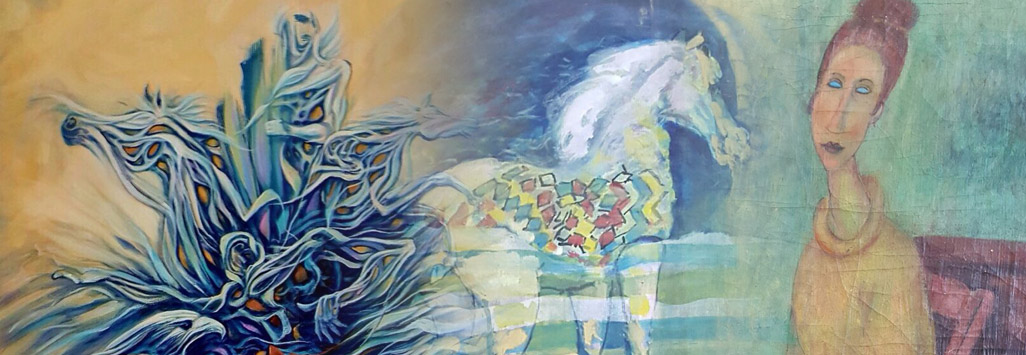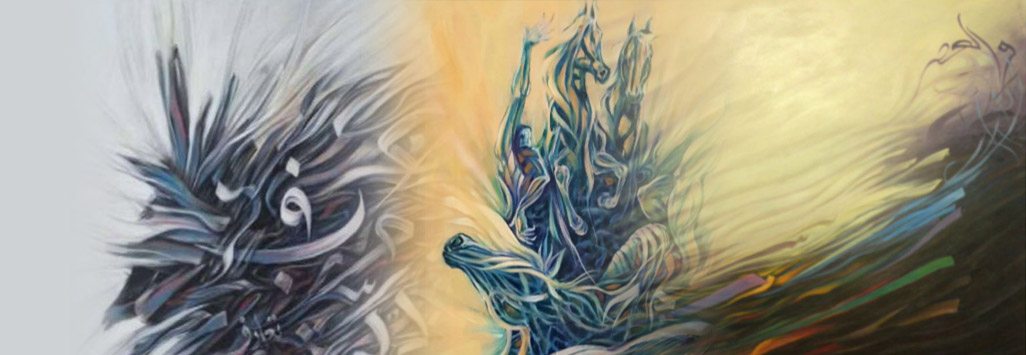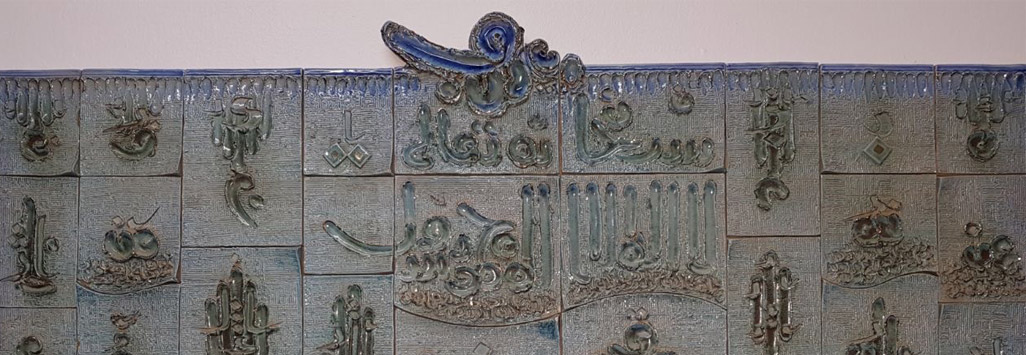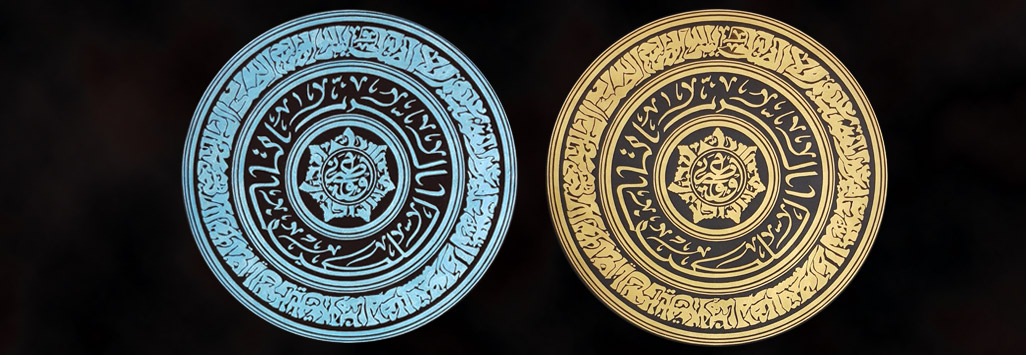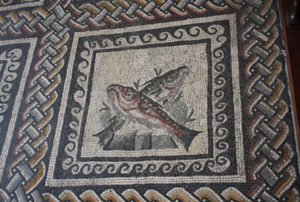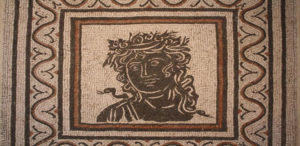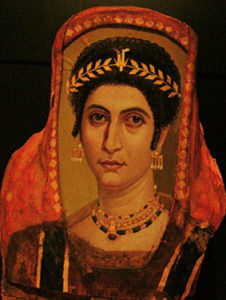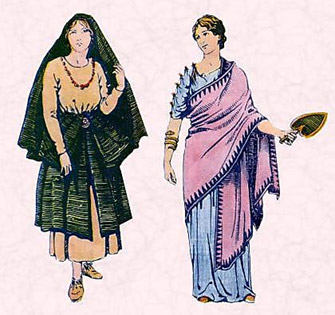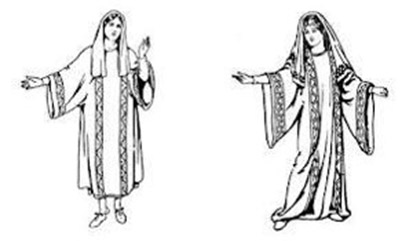Art in Ancient Roman Civilization
For several centuries Ancient Rome was the most powerful nation on earth, excelling all others at military organization and warfare, engineering, and architecture. Its unique cultural achievements include the invention of the dome and the groin vault, the development of concrete and a European-wide network of roads and bridges. Despite this, Roman sculptors and painters produced only a limited amount of outstanding original fine art, preferring instead to recycle designs from Greek art, which they revered as far superior to their own. Indeed, many types of art practiced by the Romans – including, sculpture (bronze and marble statuary, sarcophagi), fine art painting (murals, portraiture, vase-painting), and decorative art (including metalwork, mosaics, jewellery , ivory carving) had already been fully mastered by Ancient Greek artists , Of course it is wrong to say that Roman art was devoid of innovation: its urban architecture was ground-breaking, as was its landscape painting and portrait busts, we can say that Roman art was predominantly derivative and above all, utilitarian, It served a purpose, a higher good: the dissemination of Roman values along with a respect for Roman power. As it transpired, classical Roman art has been immensely influential on many subsequent cultures.
Roman Architecture
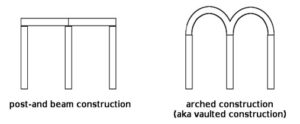 The Romans embraced Greek culture so eagerly that it became the foundation of Roman culture, Consequently, Roman forms of art and architecture emerged largely from the adoption and reshaping of Greek models, Roman art was heavily influenced by Greek, Etruscan, and Egyptian art.
The Romans embraced Greek culture so eagerly that it became the foundation of Roman culture, Consequently, Roman forms of art and architecture emerged largely from the adoption and reshaping of Greek models, Roman art was heavily influenced by Greek, Etruscan, and Egyptian art.
Roman architecture stands clearly apart from its Greek predecessors. The Romans were the first civilization to fully exploit arched construction, in which a roof is supported by arches (as opposed to post-and-beam construction, in which a roof sits directly on columns). Among older cultures, arched construction was either relatively simple (e.g. Mesopotamia) or virtually absent (e.g. Greece).
TThe principal building materials of ancient Rome were stone and concrete, though concrete dates to the earliest civilizations; the Romans were the first to build with it extensively. Concrete walls were often coated in facings of stone or brick.
– Triumphal Structures:
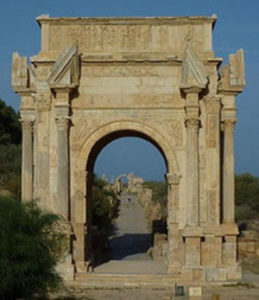 One of the most enduringly popular forms of Roman architecture is the triumphal arch, a free-standing archway built to commemorate a great event (often a military campaign). A triumphal arch often features sculpture relevant to the event in question, such as narrative reliefs or crowning statues. Large triumphal arches sometimes have two sub-arches flanking the main central arch.
One of the most enduringly popular forms of Roman architecture is the triumphal arch, a free-standing archway built to commemorate a great event (often a military campaign). A triumphal arch often features sculpture relevant to the event in question, such as narrative reliefs or crowning statues. Large triumphal arches sometimes have two sub-arches flanking the main central arch.
– Roads and Aqueducts:
As the Roman state expanded, so did its networks of roads and aqueducts, Roman aqueducts which provided gravity-fed streams of water for drinking supplies and baths.
– Pax Romana Architecture:
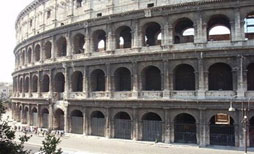 Largest of all Roman buildings was the amphitheatre known as the Colosseum, The layout of the modern stadium, which allows the efficient flow of thousands of spectators, was established by this building. The exterior of the Colosseum features the popular classical motif of superimposed orders (in which orders are arranged vertically, from simplest at the bottom to most elaborate at the top), which dates to the Hellenistic era.
Largest of all Roman buildings was the amphitheatre known as the Colosseum, The layout of the modern stadium, which allows the efficient flow of thousands of spectators, was established by this building. The exterior of the Colosseum features the popular classical motif of superimposed orders (in which orders are arranged vertically, from simplest at the bottom to most elaborate at the top), which dates to the Hellenistic era.
– Late Empire Architecture:
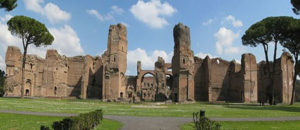 The Early Roman Empire (ca. 0-200), also known as the Pax Romana (Roman Peace), was the most prosperous and stable age of Roman history , Unsurprisingly, the masterpieces of Roman architecture date chiefly from this period. Nonetheless, the Late Roman Empire (ca. 200-500) had its share of magnificent buildings, and holds particular interest as a transitional phase to the middle Ages.
The Early Roman Empire (ca. 0-200), also known as the Pax Romana (Roman Peace), was the most prosperous and stable age of Roman history , Unsurprisingly, the masterpieces of Roman architecture date chiefly from this period. Nonetheless, the Late Roman Empire (ca. 200-500) had its share of magnificent buildings, and holds particular interest as a transitional phase to the middle Ages.
The most ambitious construction project of the Late Empire was the Baths of Caracalla, while baths were a standard feature of Roman cities; the Baths of Caracalla were exceptionally large and luxurious. In addition to actual baths (hot, lukewarm, and cold), the complex included exercise rooms, swimming pools, lecture halls, and libraries, the interior was richly decorated with murals, sculptures, mosaics, and stucco.
– Early Christian Architecture:
 The Late Empire was the final age of Roman art and architecture. It was also the first age of Christian art and architecture consequently, this period is also known as the Early Christian age (ca. 200-500), Early Christian churches typically featured plain exteriors, interiors were often richly decorated.
The Late Empire was the final age of Roman art and architecture. It was also the first age of Christian art and architecture consequently, this period is also known as the Early Christian age (ca. 200-500), Early Christian churches typically featured plain exteriors, interiors were often richly decorated.
Painting:
Roman painting survives mainly in the form of murals and panel portrait, this style descends from Classical/Hellenistic Greek painting.
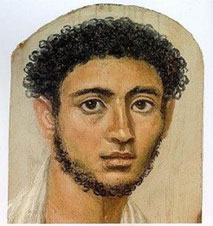 Roman murals can be divided into two types: pagan (which have been discovered mainly at Pompeii) and Early Christian (which survive primarily in the networks of catacombs beneath Rome). Most surviving Roman panel paintings are Egyptian mummy portraits, prepared upon the subject’s death for inclusion in burial. These portraits, which comprise the only large preserved body of ancient panel painting, were produced under the Roman Empire (of which Egypt was a province), Encaustic (paint with a wax binder) was the usual medium, as opposed to tempera (paint with a water-based binder, like egg yolk); this fact, along with the arid Egyptian climate, was key to the portraits’ survival.
Roman murals can be divided into two types: pagan (which have been discovered mainly at Pompeii) and Early Christian (which survive primarily in the networks of catacombs beneath Rome). Most surviving Roman panel paintings are Egyptian mummy portraits, prepared upon the subject’s death for inclusion in burial. These portraits, which comprise the only large preserved body of ancient panel painting, were produced under the Roman Empire (of which Egypt was a province), Encaustic (paint with a wax binder) was the usual medium, as opposed to tempera (paint with a water-based binder, like egg yolk); this fact, along with the arid Egyptian climate, was key to the portraits’ survival.
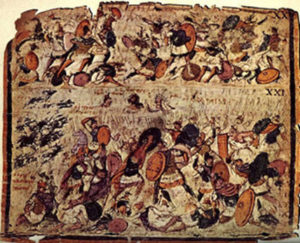 A third form of Roman painting (along with murals and panels) was illumination: painted decoration of manuscripts. Once again, the Romans absorbed this art from the Greeks, who practiced it in Egypt (during the Hellenistic period) upon papyrus scrolls , While no Greek illumination survives, modest amounts of Roman work does, due largely to the Roman use of parchment (adult animal skin) and vellum (young animal skin) rather than papyrus, which is much less durable. The style of Roman illumination reflects that of Roman mural painting.
A third form of Roman painting (along with murals and panels) was illumination: painted decoration of manuscripts. Once again, the Romans absorbed this art from the Greeks, who practiced it in Egypt (during the Hellenistic period) upon papyrus scrolls , While no Greek illumination survives, modest amounts of Roman work does, due largely to the Roman use of parchment (adult animal skin) and vellum (young animal skin) rather than papyrus, which is much less durable. The style of Roman illumination reflects that of Roman mural painting.
Knowledge of pagan Roman murals springs mainly from the city of Pompeii (and other nearby settlements), buried under many feet of ash and pumice by the eruption of Mount Vesuvius in the year 79 , This deadly ash blanket converted Pompeii into a vast time capsule, providing modern archaeologists with a rare glimpse into many aspects of Roman life.
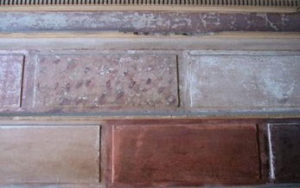 One of these aspects was wall painting, by studying works at Pompeii (and the surrounding region), art historians have identified four consecutive styles, dubbed the Pompeian styles.
One of these aspects was wall painting, by studying works at Pompeii (and the surrounding region), art historians have identified four consecutive styles, dubbed the Pompeian styles.
The first style, which could be called the “masonry style“, creates the illusion that a wall is composed of stone blocks (especially marble) of various colours and patterns. Sometimes other architectural elements (e.g. entablatures, pilasters) are also painted in. This style, adopted from the Hellenistic Greeks, flourished in the two centuries leading up to the Roman Empire period.
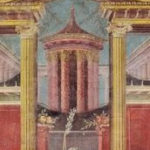 The first style thus embodies a quite rudimentary aesthetic, the three subsequent Pompeian styles, on the other hand, are highly developed and distinctly Roman. The first style may therefore be considered a prelude to the “real” history of pagan Roman wall painting, which spans Pompeian styles two through four. Together, the final three Pompeian styles stretch roughly from the beginning of the Roman Empire (which lies a few decades BC).
The first style thus embodies a quite rudimentary aesthetic, the three subsequent Pompeian styles, on the other hand, are highly developed and distinctly Roman. The first style may therefore be considered a prelude to the “real” history of pagan Roman wall painting, which spans Pompeian styles two through four. Together, the final three Pompeian styles stretch roughly from the beginning of the Roman Empire (which lies a few decades BC).
 The second style could be named the “three-dimensional style“. A scene is painted with realistic shading and deep perspective, creating the illusion that one is looking through the wall at a scene beyond. In some cases, the scene is framed with architectural elements, as though one were looking out from inside a building.
The second style could be named the “three-dimensional style“. A scene is painted with realistic shading and deep perspective, creating the illusion that one is looking through the wall at a scene beyond. In some cases, the scene is framed with architectural elements, as though one were looking out from inside a building.
 In the third style, which could be dubbed the “tapestry style“, rectangular areas of solid color are the dominant visual effect, each rectangle is sparsely covered with fine decorative elements (e.g. arabesques, miniature figures), yielding the overall impression of a wall covered in large, and lightly embroidered tapestries. Sometimes a realistic scene is embedded among the tapestries, as though it were a framed painting hanging on the wall.
In the third style, which could be dubbed the “tapestry style“, rectangular areas of solid color are the dominant visual effect, each rectangle is sparsely covered with fine decorative elements (e.g. arabesques, miniature figures), yielding the overall impression of a wall covered in large, and lightly embroidered tapestries. Sometimes a realistic scene is embedded among the tapestries, as though it were a framed painting hanging on the wall.
The fourth style, which could be termed the “hybrid style”, simply merges the second and third styles. Deep perspective and three-dimensional architecture are merged with the rectangular “tapestries” and “framed paintings” described above.
– Early Christian:
The Early Christian age of art history was the first period during which a large body of Christian-themed art was produced. This period was roughly simultaneous with the Late Roman Empire (ca. 200-500); the primary body of Early Christian painting is found upon the walls of the Roman catacombs.
The Roman catacombs gave rise to the foremost bodies of Early Christian painting (in the form of murals) and sculpture (in the form of sculpted tombs).
Since catacomb paintings were intended mainly to communicate the importance of biblical figures and events (rather than to serve as beautiful works of art), they shun realism for a flat, hastily-sketched style. Perspective and shading are weak (compared to earlier Roman painting), and backgrounds are simplified. Early Christian murals thus embody the transitional phase between the smooth realism of earlier Roman painting and the rigid stylization of medieval art.
Early Christian painters naturally adopted many elements of pagan Roman art. For instance, Christ is often depicted as a shepherd (a common representation of a wise, virtuous person in classical art) or in a similar manner to a classical god, other times, Christ is represented more covertly, via symbols (e.g. fish, bread, wine). The traditional winged creature symbols of the four evangelists also developed during the Early Christian period: Man (Matthew), Lion (Mark), Bull (Luke), and Eagle (John).
Mosaic
Roman mosaics were a common feature of private homes and public buildings across the empire from Africa to Antioch , Not only are mosaics beautiful works of art in themselves but they are also an invaluable record of such everyday items as clothes, food, tools, weapons, flora and fauna. They also reveal much about Roman activities like gladiator contests, sports, agriculture, and hunting and sometimes they even capture the Romans themselves in detailed and realistic portraits.
Mosaics were by no means limited to flooring, Vaults, columns and fountains were often decorated with mosaic and especially in baths. The earliest example of this use dates to the mid-1st century BCE in the nymphaeum of the ‘Villa of Cicero’ at Formiae where chips of marble, pumice and shells were used. In other locations pieces of marble and glass were also added the whole giving the effect of a natural grotto. By the 1st century CE more detailed mosaic panels were also used to embellish Nymphaea and fountains. In Pompeii and Herculaneum the technique was also used to cover niches, walls and pediments and once again these murals often imitated original paintings. The walls and vaults of later Imperial Roman baths were also decorated in mosaic using glass which acted as a reflective of the sunlight hitting the pools and created a shimmering effect, the floors of the pools themselves were often set with mosaic as were the floors of mausolea, sometimes even incorporating a portrait of the deceased. Once again, the Roman use of mosaics to decorate wall space and vaults would go on to influence the interior decorators of Christian churches from the 4th century CE.
Sculpture
Roman art is founded upon that of the Greeks; Roman sculpture is essentially the continuation and expansion of Greek sculpture, the formative age of Roman sculpture (and art generally) was the Republic (ca. 500 BC-0), while the mature age was the Empire (ca. 0-500), In addition to mythological works, the Romans produced a great volume of civic sculpture celebrating statesmen and their achievements.
 Roman sculpture can be divided into three main forms: statues, busts, and architectural, Busts of emperors and other public figures were common throughout the Empire. Civic pride was also expressed in the form of architectural sculpture, including narrative reliefs upon triumphal arches and columns.
Roman sculpture can be divided into three main forms: statues, busts, and architectural, Busts of emperors and other public figures were common throughout the Empire. Civic pride was also expressed in the form of architectural sculpture, including narrative reliefs upon triumphal arches and columns.
Roman Sculpture, with artists from across a huge empire and changing public tastes over centuries, is above all else, remarkable for its sheer variety and eclectic mix, The art form blended the idealized perfection of earlier Classical Greek sculpture with a greater aspiration for realism and absorbed artistic preferences and styles from the East to create images in stone and bronze which rank among the finest works from antiquity. Aside from their own unique contribution, Roman sculptors have also, with their popular copies of earlier Greek masterpieces, preserved for posterity invaluable works which would have otherwise been completely lost to world art.
 Roman sculpture did, however, begin to search for new avenues of artistic expression, moving away from their Etruscan and Greek roots, and, by the mid-1st century CE, Roman artists were seeking to capture and create optical effects of light and shade for greater realism. By later antiquity, there was even a move towards impressionism using tricks of light and abstract forms.
Roman sculpture did, however, begin to search for new avenues of artistic expression, moving away from their Etruscan and Greek roots, and, by the mid-1st century CE, Roman artists were seeking to capture and create optical effects of light and shade for greater realism. By later antiquity, there was even a move towards impressionism using tricks of light and abstract forms.
Sculpture also became more monumental with massive, larger-than-life statues of emperors, gods and heroes such as the huge bronze statues of Marcus Aurelius on horseback or the even bigger statue of Constantine I (only the head, hand and some limbs survive), both of which now reside in the Capitoline Museums of Rome. Towards the end of the Empire, sculpture of figures tended to lack proportion, heads especially were enlarged, and figures were most often presented flatter and from the front, displaying the influence of Eastern art.
As with the Greeks, the Romans loved to represent their gods in statues, Statues could also be used for decorative purposes in the home or garden and they could be miniaturized, especially in precious metals such as silver. One type of such statues which were peculiar to the Romans was the Lares Familiars, These were usually in bronze and represented the spirits which protected the home, and they were typically displayed in pairs in a niche within the house and are youthful figures with arms raised and long hair who typically wears a tunic and sandals.
However, it is in the specific area of portraiture that Roman sculpture really comes to the fore and differentiates itself from other artistic traditions; the realism in Roman portrait sculpture may well have developed from the tradition of keeping wax funeral masks of deceased family members in the ancestral home which were worn by mourners at family funerals. These were very often accurate depictions where even the defects and less flattering physical aspects of a particular face were recorded, Transferred to stone, we then have many examples of private portrait busts which move away from the idealized portraits of earlier sculpture and present the subject as old, wrinkled, scarred or flabby.
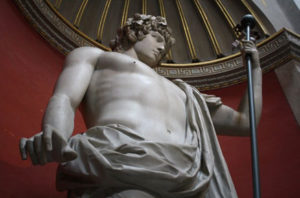 For official portraits of the ruling elite, in contrast to lower class subjects, the subject continued to be idealized, for example, the statue of Augustus as Pontifex Maximus has the emperor looking much more youthful and fresh-faced than he actually was at the time of sculpting (end of the 1st century BCE). However, by the time of Claudius in the mid 1st century CE, and even more so under Nero and the Flavian emperors, official portraiture on occasion strove for more realism. In the same period female portraits are also notable for their elaborate hairstyles and they no doubt were prime instigators in fashion trends.
For official portraits of the ruling elite, in contrast to lower class subjects, the subject continued to be idealized, for example, the statue of Augustus as Pontifex Maximus has the emperor looking much more youthful and fresh-faced than he actually was at the time of sculpting (end of the 1st century BCE). However, by the time of Claudius in the mid 1st century CE, and even more so under Nero and the Flavian emperors, official portraiture on occasion strove for more realism. In the same period female portraits are also notable for their elaborate hairstyles and they no doubt were prime instigators in fashion trends.
[top…]
Fashion in the Roman ERA
 The Romans took the Greeks from their arts, literature, statues, theaters, buildings and even their religion.One of the most important features of Roman fashion was that it was often taken from Greek fashion .The Romans did not have time for creativity, because they were preoccupied with wars and conquests, but the Romans were interested in the diversity of the colors of textiles, and were used in the use of ornamental.
The Romans took the Greeks from their arts, literature, statues, theaters, buildings and even their religion.One of the most important features of Roman fashion was that it was often taken from Greek fashion .The Romans did not have time for creativity, because they were preoccupied with wars and conquests, but the Romans were interested in the diversity of the colors of textiles, and were used in the use of ornamental.
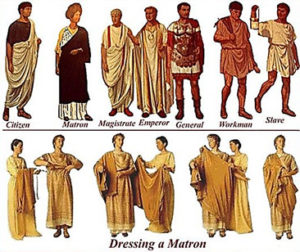 The Roman people were divided into two classes: the aristocrats and the general public, where the aristocrats were of ancient origins and were the owners of the land, and the general people were mainly representing the industrialists and peasants as workers in the territory and property of the aristocracy. This social division was clearly reflected in fashion. The kings and the aristocrats wools from minor Asia and the silk from China, which was expensive and weighed in gold, wore a variety of colors and dyes, embroidered with gold.While the general folk usually wore coarse raw materials in their natural colors.
The Roman people were divided into two classes: the aristocrats and the general public, where the aristocrats were of ancient origins and were the owners of the land, and the general people were mainly representing the industrialists and peasants as workers in the territory and property of the aristocracy. This social division was clearly reflected in fashion. The kings and the aristocrats wools from minor Asia and the silk from China, which was expensive and weighed in gold, wore a variety of colors and dyes, embroidered with gold.While the general folk usually wore coarse raw materials in their natural colors.
– Fashion Romanian women
It was not easy to distinguish Romanian clothes from Greek clothes. Roman clothing also shows the foreign influence due to the large number of conquests which had the greatest effect in their transformation from the traditional method of wrapping the cloth around the body to the modern method of detail. Gradually Roman fashion lost its characteristic lines of paganism and gave its owner beauty, and the Romans relied on excessive adornment to highlight their beauty.
The Romans invented the robe known as Ataiwjh / Altoja (Toga) ,a Roman robe purely worn by the Romans leaders on all occasions that they were victorious in, and the color of the dress Altoja determines the status of the person in the Roman society, also women that were divorced have worn it.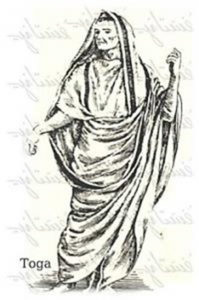
 The distinctive outfit of the married Romanian woman was the Stola, a Greek uniform, made of wool or silk.The stella was worn over the tunic or tunic, a broad robe long enough to cover the tunica, which was fixed around the body with belts, and made up of broad folds on the chest, and sometimes the stula was attached to the shoulders by pins or broaches.
The distinctive outfit of the married Romanian woman was the Stola, a Greek uniform, made of wool or silk.The stella was worn over the tunic or tunic, a broad robe long enough to cover the tunica, which was fixed around the body with belts, and made up of broad folds on the chest, and sometimes the stula was attached to the shoulders by pins or broaches.
The Roman woman also wore Dalmatica, a costume taken from Asia Minor, which was also worn over the Tunic. The most important feature is the wide sleeves, which were often decorated with ribbons, and was liked by Romanian ladies and is was of popular use between them. As used by high classes, was indicative of the height of the status of women and their size. The Dalmatian costume was about 20 to 25 centimeters in length and usually does not have a belt.


